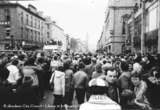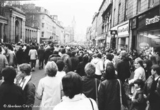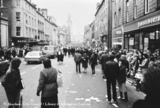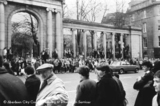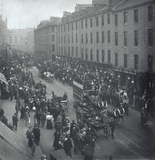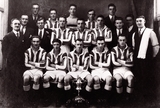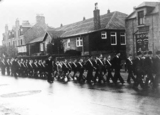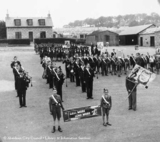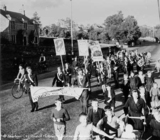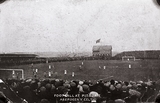|
Quick Search
|
Search Results
You searched for: More Like: 'European Cup Parade'
85 items
items as
Aberdeen Football Club League Champions 1979/80 parade
342 Aberdeen Football Club League Champions 1979/80 parade down Union Street Gala and Heather Day in the Duthie Park
395 This Adelphi Series postcard shows the Gala Day taking place in Duthie Park on 21st August 1915.
The Gala in Duthie Park and the accompanying Heather Day were both organised to raise funds for the Aberdeen Royal Infirmary.
The Gala Day is one of largest events ever to take place at the park. It was estimated that between 25,000 and 26,000 people attended. Tickets cost 6 pence (6d) for general admission and 2s 6d for carriages or motor cars.
Within the park there was an elaborate programme of entertainment and refreshments organised. Details of the programme were published in a 32 page booklet prior to the event. Upwards of 1,300 people took part in the programme.
Gates to the park opened at 3pm and the event officially commence at 3pm with a grand military parade. Lieut-Colonel A. H. Leith of Glenkindie, Garrison Commander, and Lord Provost James Taggart "took the salute" opposite the Hygiea statue.
The Gala and Heather Day were organised by a distinct committee; Taggart was its president and Alexander Findlay, Superintendent of Cleansing, was its chairman. Councillor H. J. Gray was the secretary and treasurer and Mr John Lints was his assistant. There were also conveners and secretaries for various sub-committees concerned with aspects like entertainment and refreshments.
There was a wide range of entertainment organised for within the park including singing, dancing, gymnastic displays, musical drill, motor cycle gymkhana and bayonet fighting. Various platforms saw performances from acts such as a company lead by D. M. Kinghorn, pierrots directed by Minnie Mearns, Dan Williams, and W. A. Craig's operatic choir. Charles Soutar lead a 500 strong choir of children from the city's public schools.
Practically all naval and military units present in the city were represented at the event and individuals from many of them took part in the sporting competitions. The day also included a 5-a-side football and tug of war competition. Preliminary matches for these took place prior to the day at Pittodrie Park.
The Gala Day was filmed and this was later shown as part of a special programme at the Picture House on Union Street from the 25th of the month.
Over £500 was taken at the gates for the event. Entertainment and refreshments within further increased the figure raised.
Heather Day itself generated another £474. This involved over 1,500 vendors going around all parts of the city selling sprigs of the plant. The sale started on the afternoon of the Friday and continued all through Saturday. Entertainment venues throughout the city were also visited.
The vendors were primarily young women and members of organisations like the boys brigade. Stores present in all areas of the city were replenished from a central depot at 173a Union Street. This in turn was supplied by the cleansing department buildings in Poynernook Road, where the preceding week had seen 200,000 sprigs prepared for sale. Peterhead, Inverurie, Ellon and Banchory organised their own Heather Days for the same fund.
The sum taken from both the Gala and the Heather Day was estimated at considerably over £1,000.
See the report in the Aberdeen Journal, Monday 23rd August 1915 page 8, for further details about the occasion. The Pleasure Park, Aberdeen Beach
397 A postcard showing John Henry Iles' Pleasure Park in the 1930s. The park's esplanade site, south of Wellington Street (roughly where Amadeus nightclub/the Range and part of the Queen's Links carpark would later stand), was leased to Iles by the Council in 1929. Illes was an amusement entrepreneur originally from Manchester.
The park's biggest attraction, in all senses, was the Scenic Railway roller coaster shown here. Iles was involved in several amusement parks around Britain and during a visit to New York he obtained the European rights to the design of the latest roller coasters. He subsequently erected his Scenic Railway in Aberdeen in 1929.
The roller coaster rose to 100 feet in the air at its highest point and was popular with holiday makers and locals throughout the 1930s. The local press recorded 21,000 children, between 3 and 14 years of age, carried on the ride during a special children's day that was held on Saturday 20th August 1932.
Part of the message written on the back of this postcard by a young visitor to Aberdeen reads "This picture shows you the scenic railway which I have been on and liked very much".
The Scenic Railway was sadly badly damaged by fire on the night of 5th December 1940 and was consequently demolished. Other attractions of Iles' park included rides such as The Caterpillar, The Whip, Water Dodgems, and the Brooklyn Racers (petrol driven cars).
In the background of this image be seen the tower of St. Clements Church and a row of tenements, likely those on Wellington Street. Aberdeen Football Club parade
643 Aberdeen Football Club parade down Union Street in an open topped bus after winning the European Cup in 1983. Aberdeen Football Club parade
644 Aberdeen Football Club parade down Union Street after winning the European Cup in 1983. Aberdeen Football Club European Cup parade
645 Aberdeen Football Club European Cup parade up Union Street in 1983. Aberdeen Football Club European Cup parade
646 Aberdeen Football Club European Cup parade up Union Street in 1983 Aberdeen Football Club European Cup parade
647 Aberdeen Football Club European Cup parade up Union Street in 1983 Aberdeen Football Club European Cup parade
648 Aberdeen Football Club European Cup parade up Union Street in 1983 Aberdeen Football Club European Cup parade
650 Aberdeen Football Club European Cup parade up Union Street past the facade of St. Nicholas Churchyard in 1983 Aberdeen Football Club parade
662 Aberdeen Football Club parade on Union Street with European Cup, 1983 A parade of trams along Union Street
734 Correspondent Dr Mike Mitchell informs us that this is the celebration of the take over of the Aberdeen District Tramways by Aberdeen Corporation in 1898. The photo was probably taken by Councillor Alexander Wilkie, who is recorded as having gone across the road from the Town House to photograph the parade, and was a Woodside based professional photographer. Culter
876 This image was taken around 1909 from a hill at the west end of Culter - 7 miles west from Aberdeen looking down on the North Deeside Road towards Banchory. The image shows the cottages known as Clayhills with the houses of Malcolm Road beyond. Hidden in the trees at the right hand side is the statue of Rob Roy overlooking the Leuchar Burn which runs through the wooded valley. Culter Football Club
883 A team photograph of Culter Football Club from the 1931-32 season.
Local historian Brian Coutts has been in touch with names for some of the people shown:
The fourth from the left,of the five men in the back row is David Sangster.
The middle row, of nine men, starts on the left with T. Emsie, the club secretary. 4th along is G. Petrie and the 5th is Arthur Jackson.
The front row, starting again from the left, is A.J. Moir, H. Wilson, L. Cooper, W. Jamieson and an unknown 5th man.
Brian also suggests that the trophy at the front might be the Archibald Cup. 5th/7th Gordon Highlanders parade, Bucksburn
932 5th/7th Gordon Highlanders parade through Bucksburn. 5th/7th Gordon Highlanders parade, Bucksburn
933 5th/7th Gordon Highlanders parade through Bucksburn. Boys' Brigade "Wings for Victory" parade, Culter
1005 Boys' Brigade "Wings for Victory" parade at Culter, 21st June 1943. Lower Deeside Champion Ploughing Match
1047 This image shows the Committee of the Lower Deeside Champion Ploughing Match held at West Cults Farm on the 11th February 1922. In the centre of the front row, wearing a flat cap was the Secretary William E. Gibson. Behind him was Alexander Thomson, blacksmith in Cults, and to his right, was James Burnett on whose farm the match was held. The other gentlemen came from other farms in the surrounding area. The 'Aberdeen Daily Journal' reported that the weather was excellent and all arrangements were in perfect order. There were 64 competitors who had come from as far as Kinross in the south and Morayshire in the north, each with their pairs of well matched, faultlessly groomed and harnessed Clydesdales. The match was watched by around 2000 spectators. The winner was James Mowat, Newstyle, Foveran who received a silver cup and cash prize. Grand Central Cinema, Aberdeen
1149 The Grand Central Cinema on George Street, Aberdeen.
The film being shown is Radio Parade of 1935. This starred Will Hay and dates the photograph to around 1934.
The photograph looks eastwards from Craigie Street towards the cinema on George Street.
The building at 286 George Street had previously been a furniture branch of Allan's Public Supply Stores and was on the site of an old Baptist Chapel.
(Many thanks to correspondent Ed Fowler for the additional information). Football at Pittodrie
1656 The large crowds visible in the photograph suggest that this may be the Scottish Cup semi-final of 21st March 1908. Reaching the semi-finals for the first time, Aberdeen played Celtic at Pittodrie before a record 20,000 attendance (this was prior to the introduction of neutral crowds). The Aberdeen players, seen here in their black and gold stripes of the time, lost 1-0 to the visitors. |






